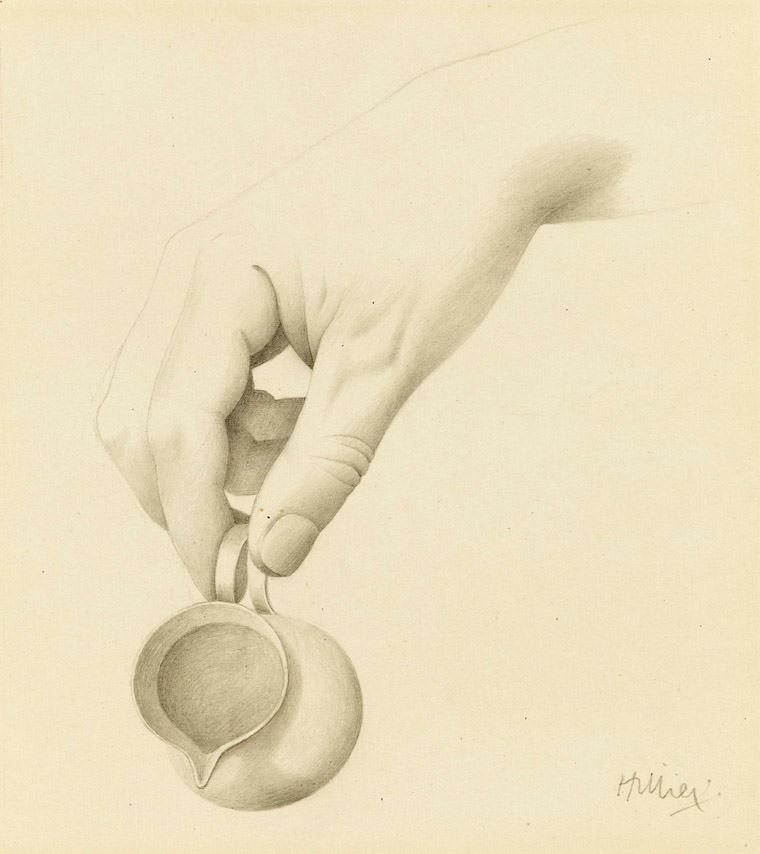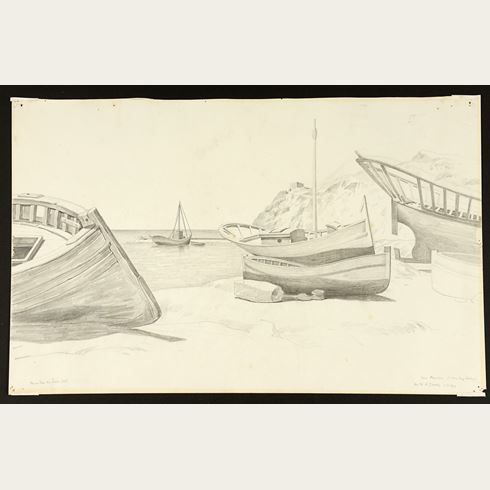Tristram Paul HILLIER
(Peking 1905 - Bristol 1983)
The Seven Sacraments: Baptism, Penance, Eucharist, Confirmation, Marriage, Ordination and Extreme Unction
Each (except Extreme Unction) signed Hillier at the lower right, lower left or upper left, and each titled and inscribed in the margins.
Each approximately 179 x 158 mm. (7 x 6 1/8 in.)
Jenny Pery, in her recent monograph on Hillier, describes the origins of this series of drawings in more detail: ‘Hillier’s delicate drawings, full of spirituality, made to illustrate the Seven Sacraments (1956-57) are all of hands engaged in the sacramental rites. The hand representing Baptism holds a jug, Confirmation is portrayed as an outstretched hand, Penance is a single upright hand, Eucharist a pair of hands holding a chalice, Extreme Unction a downward-pointing hand surrounded by an eye, ear, nose and mouth, Ordination a pair of hands knotted together and Marriage links two hands with a ring. Some of these were studies of the hands of Christopher Leyne, then art master at Downside, who in 1956 had suggested that his promising pupil Rob Stuart should take private lessons from Hillier. As Leyne wrote to Stuart: ‘Tristram, who has been up in the Attic quite a lot doing some drawings of my hands to help illustrate the Seven Sacraments, is very keen on the student having only one master.’ Hillier’s only pupil, Stuart was initially sent from Downside for weekly tutorials in Hillier’s studio, later confessing that these lessons terrified him. He did not become a ‘follower’, eventually abandoning painting in favour of picture dealing while remaining a friend and confidant. The exalted, prayerful quality of the Seven Sacraments drawings can hardly be missed. Perhaps they were an impossible act for a student to follow.’
These seven drawings were exhibited in the exhibition A Timeless Journey: Tristram Hillier R.A. at the Cartwright Hall, Bradford, and elsewhere, between 1983 and 1984.
Born in China, Tristram Hillier was trained at the Slade School of Art in London 1926 and at the Atelier Colarossi in Paris, and also spent some time in the studio of André Lhote. In Paris he met and befriended such artists as Georges Braque, André Masson and Max Ernst, and was drawn into the milieu of the Surrealists. He was active mainly as a landscape and still life painter, and also painted the occasional religious subject, all in a very precise manner with a high degree of finish. His paintings were preceded by detailed preparatory pencil drawings, executed with a confidence and exactitude that are characteristic of all of his drawings. He had his first one-man exhibition at the Lefevre Gallery in 1931, and in 1933 joined Paul Nash’s Unit One group, associating himself with the English Surrealists. Hillier lived in the South of France until the outbreak of the Second World War, after which he settled in Somerset, where he painted agricultural subjects with the same exactitude as his landscapes and still life subjects. Hillier exhibited widely in England and elsewhere, and was elected to the Royal Academy in 1957.
Tristram Hillier’s return to the Catholic faith of his childhood ensured that he remained deeply religious in his mature years. As he recalled in his autobiography, ‘One morning in a tawdry little chapel of a country town, I suddenly became aware with absolute certainty that the Miracle of the Mass which I was attending was not only true but was in fact no more remarkable than the existence of the little church itself or my own presence there…I had neither reasoned nor had I consciously prayed, but I knew at that moment and for some time afterwards a serenity of mind and a depth of happiness that I had never before imagined.’ Hillier’s religious convictions and deep spirituality was at times vividly expressed in his work.
Provenance
Literature
Exhibition











